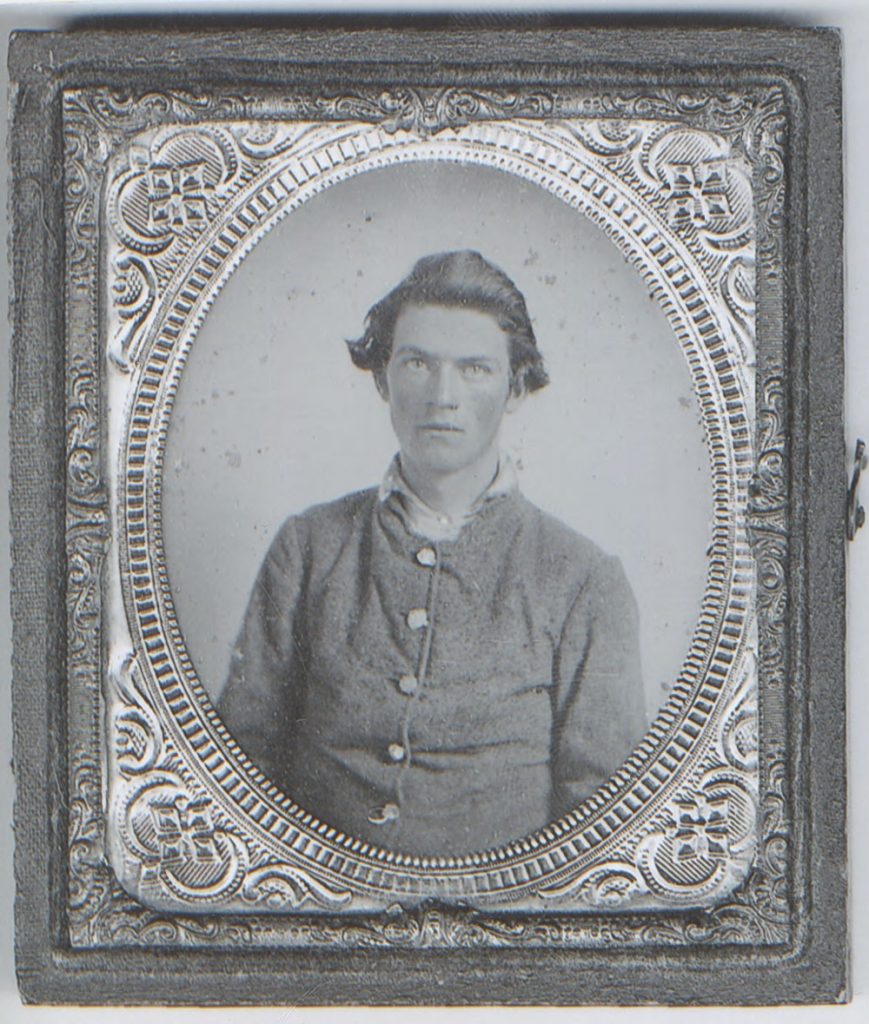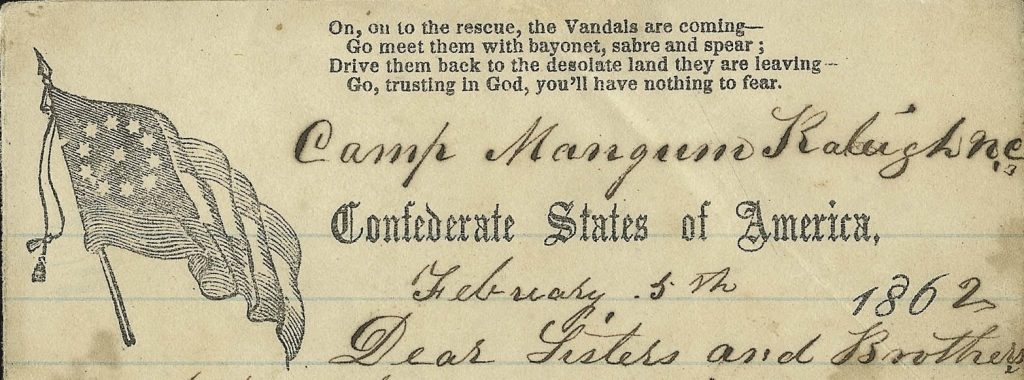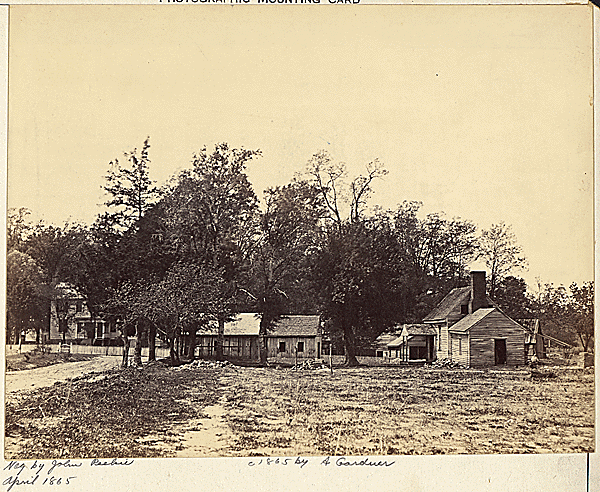Note: This is the first of a three part history of Company A of the 34th North Carolina, a company formed of troops from eastern Ashe County and western Alleghany County. This narrative attempts to detail the ultimate fate of almost every individual member of the company. Company A was one of several companies formed of troops from Ashe County during the Civil War. However, almost all of these companies were attached to the Army of Northern Virginia and experienced the same series of battles as those detailed in these articles. The next two installments will be published over the next two weeks.
In 1861, all the nation was in an uproar as tensions long festering between the northern and southern regions of the country burst forth in heated rhetoric and armed conflict. Abraham Lincoln’s election had led to the almost immediate secession of the states of the Deep South, and by spring the ‘border states’ of Virginia, Tennessee, Arkansas, and North Carolina were coming under immense pressure to join the rebellion. North Carolina, though a slave state, was reluctant to join this cause. By March, a state convention to determine North Carolina’s secession was voted on in a special election. The results illustrate a state being itself torn apart. In New Hanover County, 1,781 voters were in favor of secession, only 210 opposed; similarly, in Mecklenburg County, 1,448 voted in favor, with 252 against. Other counties, like Cleveland, Duplin, Wayne, and Edgecombe, voted overwhelmingly in favor of rebellion. However, many others adamantly opposed the decision to leave the Union. In Ashe County the overwhelming vote, 758 to 144, was in favor of remaining with the United States. A resolution written by Nathan Waugh and William Gentry, passed after a meeting at the Jefferson Courthouse, reflects the viewpoints of Ashe County citizens:
Before we would see this great country destroyed, the glories of the past sacrificed, the cause of human liberty imperiled, and thirty million free and happy men cast adrift on the bloody and boundless sea of revolution, we would appeal to every available means of reconciliation and adjustment under the Constitution and the laws – we would meet in Convention with all the States, or with the Sister Southern States alone, and try reason before the sword.
Despite these appeals to reason, the firing on Fort Sumter in Charleston harbor on April 12th, would escalate matters out of control. Despite the protests of many citizens, North Carolina too would tilt in favor of secession and find itself in a state of rebellion. The call soon went out for troops to support this cause.
Surprisingly, despite their adamant opposition to the principle of secession, Ashe County was quick to enlist troops for the new war effort. By the end of May of 1861, a company of volunteers, formed in Alleghany County, gathered in Jefferson, calling themselves the Jeff Davis Mountain Riflemen. Led by A.B. Cox, they would soon march off to Raleigh and become Company I of the 61st North Carolina Infantry. By the end of June, Ashe County’s state congressional representative Thomas Crumpler, who had stood on the floor of the North Carolina House of Commons to rail against secession, had raised a company of cavalry and marched off to Asheville to rendezvous with other volunteers from Cabarrus County.
In Eastern Ashe County, a company of volunteers was also raised. Unlike A.B. Cox’s company, this group was formed in Ashe County, and was made up primarily of Ashe County residents. This new company, calling itself The Laurel Springs Guard, was formed on August 10th, 1861.
On this day, 93 men from Ashe and Alleghany appeared and signed up for a 12 month commitment. Although it is often assumed that these early volunteers were young and naive, it seems that ‘secession fever’ had swept through large portions of the population. John F. Shepherd, who enlisted as a private, was 43. Pinkey Parrish, another enlistee, was 40. In fact, of the original 93 members, 28 were over the age of 30. Unfortunately, none of these older enlistees would make it to the end of the war: most deserted or were discharged due to infirmity within two years.

One of the more interesting characteristics of this newly formed unit of soldiers was how closely many were related. Among their members were five groups of brothers: Richard, Allen M., and James G. Richardson; George, James, and Nelson C. Woodie,; George and James Poe; Hamilton and John Koontz; Levi, David, and Hiram Cox; and Bryant, Calvin, and Talton Woodie. Aside from these direct relations, almost everyone in the group was somehow related: there were first and second cousins, in-laws, uncles and nephews.
This group was also an accurate representation of the overall population of Ashe County.The vast majority were farmers, and hardly any were slaveholders. Only 6% or so of Ashe County’s entire population owned slaves. In Company A, the ratio was even lower. Only two of the new enlistees owned slaves. And those two, George Koontz and Stephen N. Wilson, owned a combined total of three. Although slavery was no doubt the principle cause of the Civil War itself, the cause of individual enlistments, at least in these early stages, was clearly something else.
After the company was formed, a captain was needed. Stephen N. Wilson, a wealthy farmer and native of Alleghany County, was elected. Nelson C .Woodie, a 29 year old resident of Ashe, who had just enlisted along with his brothers, was elected 1st Lieutenant. Eli Chandler was chosen as 2nd Lieutenant.
After their formation, this new unit began their fateful journey through America’s bloodiest conflict. However, their first few months in the army were relatively free from hardship. After leaving Ashe, they marched down the mountain to Camp Fisher in High Point. Here, on October 25th, 1861, they were joined with other companies from around North Carolina to form the 34th North Carolina Regiment. The Laurel Springs Guard would become Company A. They remained at High Point through the end of November. The close quarters of the camp and the influx of soldiers from around the state soon led to minor disease outbreaks. Meredith Andrews, 29 years old at the time, contracted measles and was ill, though not hospitalized.
It was during this time, under the command of regiment colonel Collett Leventhorpe, that these Ashe County farmers began months of drilling. Marching techniques and maneuvers, as well as firearms and bayonet training, made up the majority of their days. They also completed tasks of manual labor around the camp. Company A, though away from home during the holiday season, subsisted well on an ample supply of flour, beef, bacon, rice and molasses, spending their days visiting with one another and meeting the other soldiers who made up their regiment, young farmers from Mecklenburg, Montgomery, and Rutherford Counties. One soldier in the camp described the scene, noting, “We have fiddling, dancing, picking the banjo, cursing plenty, preaching, praying, singing and other things that is as mean as any.”

By the middle of December, Company A was on the move again, this time arriving by train at Camp Mangum, near Raleigh. The young soldiers enjoyed the train ride, which many had never before experienced but lamented the fact that they had to spend one night sleeping unsheltered on the ground, a hardship that would seem quite trivial in just a few months. During this trip the second member of the group fell victim to minor illness: John Petty found himself in the hospital suffering from a skin infection. Martin Holdaway was soon also in the hospital, suffering from an unknown illness that would soon be diagnosed as syphilis. The rest of the company would soon move on, leaving him hospitalized in Raleigh. He would eventually succumb to his illness, dying on February 20th, 1862. He would be one of the company’s first fatalities.
By January 1st, Company A found itself an official member of the Army of the Confederacy, and once again they were setting off by rail; this time they arrived in Goldsboro, North Carolina. It was here that they were first issued firearms and uniforms, looking the part of soldiers for the first time. Here also, disease (notorious in Civil War army camps) began to appear in earnest. Calvin Sheets, confined to the hospital in Goldsboro, was dead by February the 3rd. George Poe, only 16 years old at the time, who had enlisted along with his brother James, soon followed, dying on March 9th. Richard Richardson died on March 10th. John Cox, who would succumb to disease on April 4th, was the last member of the company to die in Goldsboro.
Soon the company was involved in its first real action of the war. Fear of a Union ascension of the Roanoke River led the company of Ashe County farmers to the North Carolina coast, where they found themselves moving between Jamesville, Weldon, and Tarboro, ultimately arriving at Hamilton, where they remained for several weeks. Here Meredith Andrews, who had contracted measles shortly after enlistment, died of some more serious, unknown illness.
During this time, Captain Stephen N. Wilson oversaw the trial of a private from Company K of Montgomery County. The private, Willis Hurley, was accused of stealing coffee. Although he pleaded not guilty, Captain Wilson sentenced him to hard labor on the coast of North Carolina for the remainder of the war.
It was at this time that the entire Confederate Army was reorganized. Soldiers were asked to reenlist for longer terms and reelect officers. Despite the rapidly increasing rate of death due to disease, members of Company A were still devoted to the cause of Southern independence, and all signed up to serve for three years, or the duration of the war. They chose to reelect Stephen Wilson as Captain, but Hiram Cox, the company’s 2nd lieutenant, was defeated by Franklin Long, who became the company’s newest officer. Cox quit the unit in anger, but would reenlist the next year.
Company A’s service almost immediately became more intense. On April 23rd, they were placed on a train for Richmond – the furthest from home most had ever been. Two weeks after their arrival, Eli Chandler, the unit’s 2nd Lieutenant, resigned for an unknown reason and left the company. Franklin Long, who had just been elected a few weeks earlier, became the unit’s ranking 2nd Lieutenant.
John Stephens, who was 36 at the time of his enlistment, died near Richmond from disease and John W. Shepherd, suffering from syphilis, was discharged due to disability. During this period, Company A was briefly moved near Fredericksburg, but then returned to Richmond. They came within sight of Union lines, allowing the soldiers from Ashe County to see the northern soldiers massed against them for the first time. However, by June of 1862, no member of Company A had yet suffered any injury due to combat. By July, that would all change.

Nervous about their impending engagement, the Company moved into position near Mechanicsville, where they, along with other members of A.P. Hill’s Division, were to clear The Meadow Bridge and the Mechanicsville Turnpike. For the first time in the war, Company A would raise the ‘rebel yell’ and charge into battle. After their initial attack, they found themselves just in front of the Union defenses, which were set up along Beaver Dam Creek. Company A was part of the regiment ordered to take out an artillery position on the end of the Federal lines. However, their attack was unsuccessful, and they found themselves trapped, knee deep in a creek, being bombarded by artillery. After exchanging fire, they were ordered to withdraw. No one was killed, but Allen M. Richardson, whose brother Richard had already died of disease in Goldsboro, was shot in the arm – he was the first member of the Company to suffer a combat related injury.
The next day the fighting was even more intense. Leaving their defenses, the Union lines withdrew to a position near Gaine’s Mill, Virginia. Company A was part of the Brigade ordered to open the day’s fighting. For the first time, members of the Company saw General Lee himself, who rode by as they were being formed into a battle line. Their brigade commander, General Pender, made sure to note that “The eyes of the chieftain are upon you.”
Company A found themselves facing an entrenched Union position opposite a ravine. Sharpshooters in the woods and lines of infantry along the ridge were arrayed against the newly formed Confederate lines. The battle at Gaine’s Mill would be remembered by members of the 34th North Carolina Regiment as the fiercest gun fight of the war. Bullets rained down like hail from the Union positions as the Confederate soldiers tried repeatedly to break through the enemy’s defenses. The 1st South Carolina Rifles, a regiment also engaged in the fight, suffered the highest casualty rate, losing 57% of their force. However, Company A, in the vanguard of the attack, miraculously survived relatively intact. Although the larger regiment suffered 37 killed and 84 wounded, Company A only suffered a single casualty. Thomas J. Andrews, only 19 years old, was killed in battle, the first combat death suffered by the company. Later that same day, Hiram Long, who quickly realized what the nature of war was truly going to be, deserted the company. He would not be the last.